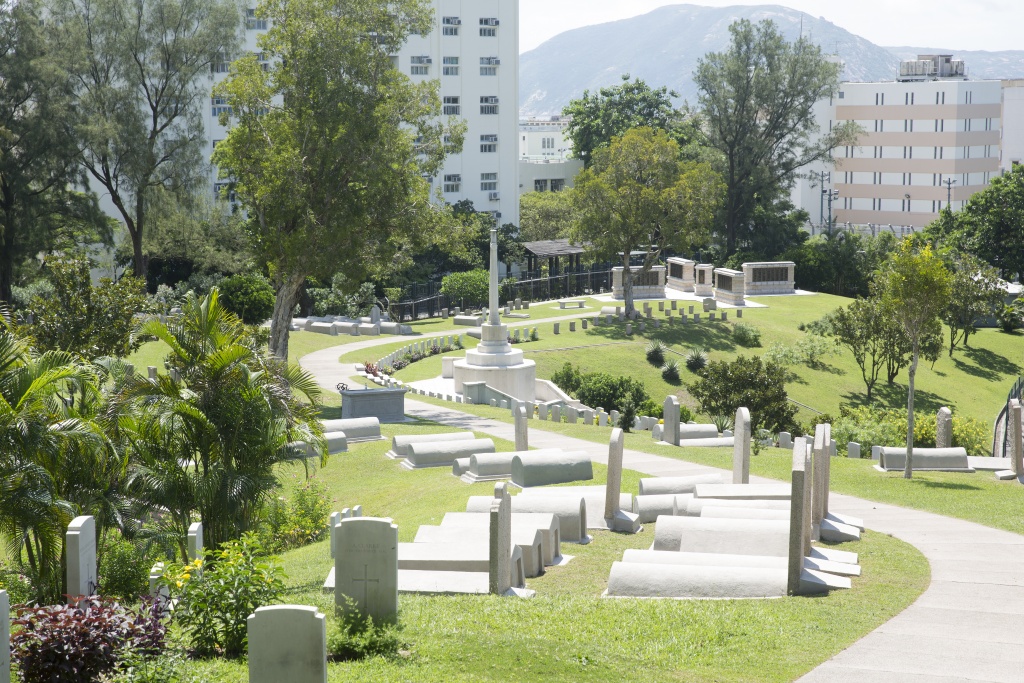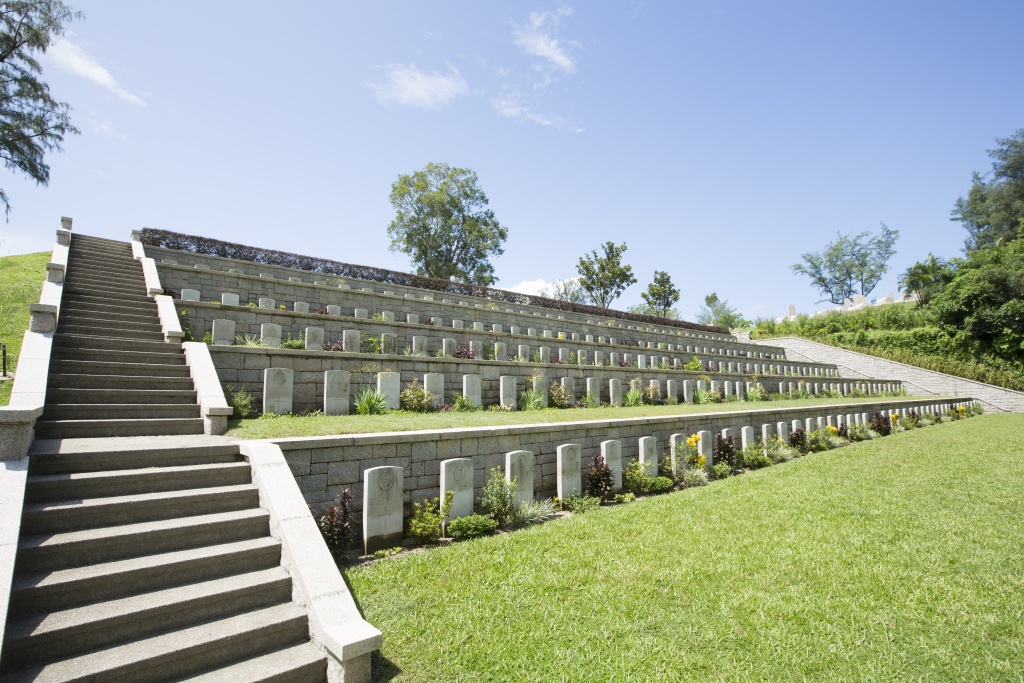Stanley Military Cemetery
- Country China, (including Hong Kong)
- Total identified casualties 426 Find these casualties
- Identified casualties from First & Second World War
- GPS Coordinates Latitude: 22.21315, Longitude: 114.21613
Please note
It is important to check the weather forecast before planning a visit. Please take shelter in the staff room, if required.
The cemetery is located on an exposed slope, with a large number of steep and narrow steps, on many different levels.
Please be aware that there may be snakes present in the cemetery.
Location information
Stanley Military Cemetery is just beyond the town of Stanley in the southern part of Hong Kong island on the Tai Tam Peninsula.
From Stanley take the Wong Ma Kok Road. The cemetery is adjacent St Stephen's College and is close to St Stephen's beach. It is reached from Victoria by car along a winding, hilly road which at first overlooks the harbour and mainland. After climbing to the pass called Wong Nei Cheng Gap the road descends to the sea at Repulse Bay and then continues along the rocky hillside to Stanley.
The cemetery is located Wong Ma Kok Road, Stanley, Hong Kong Island. Take bus routes Nos. 6, 6X or 260 to Stanley prison from Exchange Square bus terminus, adjacent to Exit B1 of mass transit railway Hong Kong station and alight at Stanley village (Stanley market) bus stop on Stanley Village Road. Follow the direction signs and walk towards south along Wong Ma Kok Road for approximately 800 metres.
To travel to Stanley Military Cemetery from Sai Wan Cemetery walk upwards along Cape Collinson Road for approximately 600 metres to Shek O Road then turn right onto Tai Tam Road. Take bus route No. 14 to Stanley Fort and alight at St Stephens’s College Preparatory School bus stop on Wong Ma Kok Road then walk back in the opposite direction for approximately 100 metres.
Visiting information
ARRIVAL
The cemetery is triangular in shape and built on a steep and exposed slope. There are many stone steps and concrete pathways leading into and around various levels in the cemetery. Visitors should check the weather forecast before visiting as the steps may be slippery when wet.
PARKING
The only parking available is directly in front of the main entrance to the cemetery, a layby is offset from the main road. There are bollards and chain railings indicating the parking area.
MAIN ENTRANCE, ACCESS & LAYOUT
From the car park area, two-metre-wide low metal gates open onto four steep flights of stone steps.
The steps have handrails and lead up to the Cross of Sacrifice which is visible from the main road and parking area.
A Register Box is behind the Cross of Sacrifice, facing into the cemetery.
There are some seating areas (stone benches) scattered around the cemetery and can be found on the upper level of the site.
There are concrete pathways and leading to the Hong Kong Memorial (eastern end of main math) and stairs (approximately 40 steps) leading down to the lower part of the cemetery. Another memorial sits at the western end of the main path that is surrounded by uneven cobbles. There are drainage channels throughout the cemetery, with those adjacent to pathways covered with concrete gratings.
ALTERNATIVE ACCESS
There are no alternative entrances or access point into the cemetery.
ADDITIONAL INFORMATION
The cemetery is open 0800 hrs – 1700 hrs
Please note at there may be snakes present in the cemetery.
History information
On the same morning as the attack on Pearl Harbor, Japanese Forces attacked the British Colony of Hong Kong. Following a brief but intense period of fighting the Hong Kong Garrison, which consisted of Indian, British and Canadian units was forced to surrender on Christmas Day 1941. During the Japanese occupation, Stanley jail and village were used as a prisoner of war and civilian internment camp and the cemetery, which had not been used for more than 70 years, was reopened for burials from the camp. After the war, the cemetery was extended on its northern side when graves were brought in from civilian burial grounds and isolated sites in the surrounding country.
Although the cemetery as a whole is laid out and maintained as a military cemetery, in the older part, service graves and the graves of civilian internees who died during the Japanese occupation are intermingled. A number of the graves in this part of the cemetery are still marked by the original headstones erected by the prisoners of war, who collected the granite from the 19th century fortifications and carved the inscriptions themselves.
Nearly all casualties of the local defence forces, chiefly the Hong Kong Volunteer Defence Force and the British Army Aid Group, are buried in this cemetery. The British Army Aid Group was a military establishment which came into being early in 1942 to encourage and facilitate escapes, to assist escapees and to get information and medical supplies into the camps. Attached to the establishment was a large staff of civilian employees operating in an extensive area of enemy held territory and the group gradually developed into an organisation for the collection of intelligence of military value and later into an escape and evasion organisation for the American Air Force.
There are now 595 Commonwealth servicemen of the Second World War buried or commemorated in this cemetery. 176 of the burials are unidentified, but a number of special memorials commemorate casualties known to be buried among them. The names of the 96 civilian internees buried in this cemetery are recorded in volume 7 of the Civilian War Dead Roll of Honour.
The cemetery also contains the new Hong Kong Memorial (unveiled in 2006), which commemorates, by name, Chinese casualties of the two world wars who have no known grave. There are also three special memorials to First World War casualties buried in cemeteries in Kowloon and Hong Kong, whose graves have since been lost.







